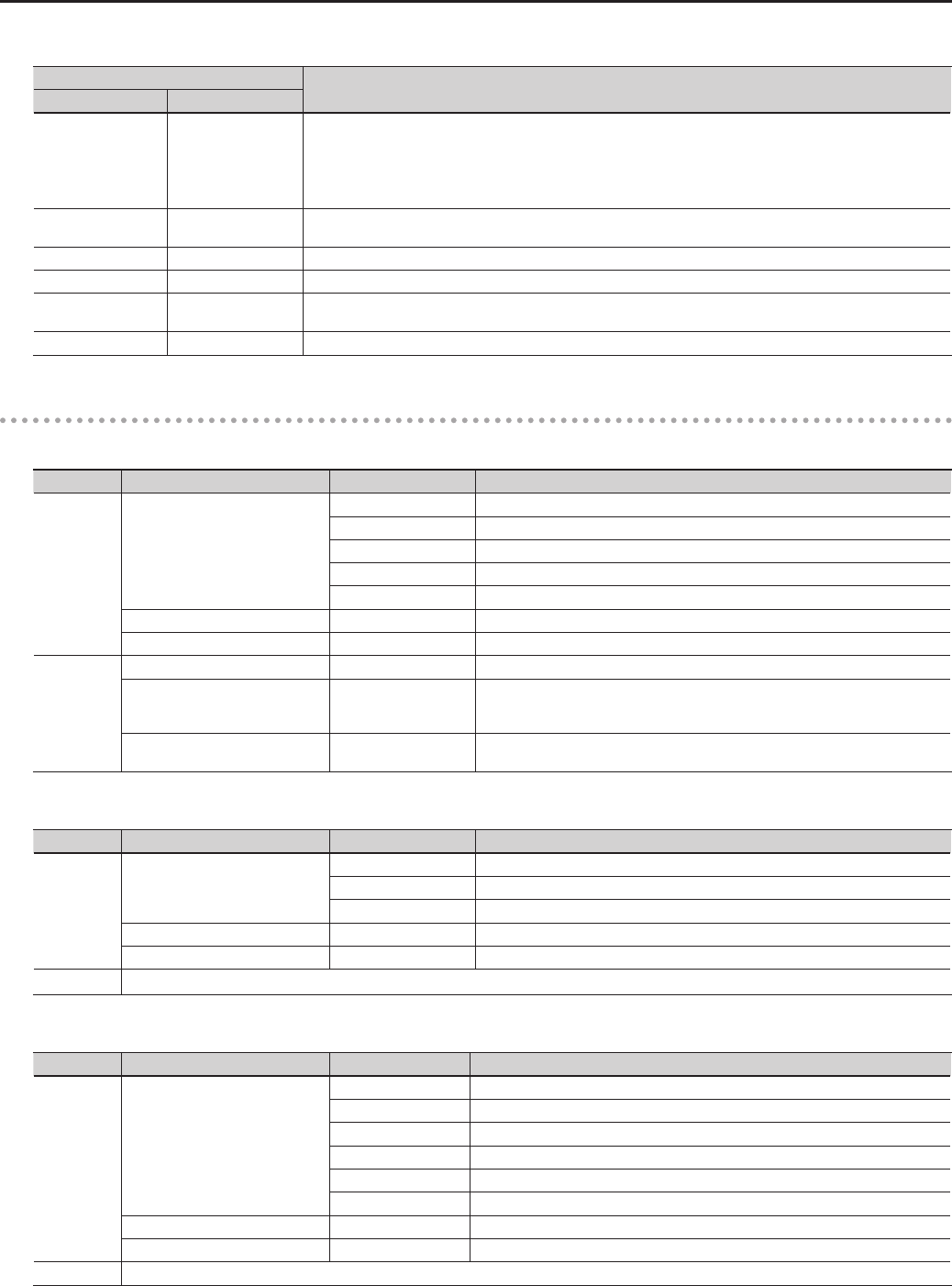
31
Editing the Tones (TONE)
TONE CATEGORY: SYNTH
TONE NUMBER (PICKUP)
Description
GUITAR BASS
18: ANALOG GR 10: ANALOG GR
This is the sound of a classic analog polyphonic guitar (bass) synthesizer.
It provides hexa-distortion, with a hexa-VCO and VCF (variable frequency lter) that generates independent
pitch-shiftable sawtooth waves for the six strings, letting you enjoy analog synthesizer sounds that reect the nuances
of your guitar or bass performance.
To change the pitch, use “PITCH A/B” (p.36).
19: WAVE SYNTH 11: WAVE SYNTH
This algorithm directly processes the string signal from the GK pickup to produce the synthesizer sound. It allows a
natural performing feel.
20: FILTER BASS 12: FILTER BASS This instrument is similar to a bass synth with a lter applied.
21: CRYSTAL 13: CRYSTAL This is an instrument with a metallic resonance.
22: ORGAN 14: ORGAN
This is a sustained-tone instrument suitable for solo parts or slow songs. As on an organ, you can adjust the volume
level balance of three parameters (FEET 16, 8, 4) to create the desired tone.
23: BRASS 15: BRASS This instrument produces a clear brass type sound good for leads.
E.GTR
CLA-ST, MOD-ST, ST
Group Parameter Value Description
PU
PU SEL #
REAR Simulates the sound produced when the rear pickup is used.
R+C Simulates the sound produced when both rear and center pickups are used.
CENTER Simulates the sound produced when the center pickup is used.
C+F Simulates the sound produced when both center and front pickups are used.
FRONT Simulates the sound produced when the front pickup is used.
VOLUME 0–100 Sets the volume. With a setting of 0, there will be no sound.
TONE # 0–100 Adjusts the tone. The standard value is 100; lowering the value creates a softer tone.
NS
SWITCH OFF, ON Turns the noise suppressor on/o.
THRESHOLD # 0–100
Adjust this according to the level of the noise. Set this to a higher value if the noise
level is high, or to a lower value if the noise level is low. Adjust this so that the decay of
your guitar still sounds natural.
RELEASE 0–100
Species the time from when the noise suppressor begins to operate until the volume
is completely attenuated.
H&H-ST, TE, LP, P-90, RICK, 335, L4
Group Parameter Value Description
PU
PU SEL #
REAR Simulates the sound produced when the rear pickup is used.
R+F Simulates the sound produced when both rear and front pickups are used.
FRONT Simulates the sound produced when the front pickup is used.
VOLUME 0–100 Sets the volume. With a setting of 0, there will be no sound.
TONE # 0–100 Adjusts the tone. The standard value is 100; lowering the value creates a softer tone.
NS Refer to the NS section of the table for the “CLA-ST, MOD-ST, ST” model in the “E.GTR” section (p.31).
LIPS
Group Parameter Value Description
PU
PU SEL #
REAR Simulates the sound produced when the rear pickup is used.
R+C Simulates the sound produced when both center and rear pickups are used.
CENTER Simulates the sound produced when the center pickup is used.
C+F Simulates the sound produced when both center and front pickups are used.
FRONT Simulates the sound produced when the front pickup is used.
ALL Simulates the sound produced when all pickups are used.
VOLUME 0–100 Sets the volume. With a setting of 0, there will be no sound.
TONE # 0–100 Adjusts the tone. The standard value is 100; lowering the value creates a softer tone.
NS Refer to the NS section of the table for the “CLA-ST, MOD-ST, ST” model in the “E.GTR” section (p.31).


















